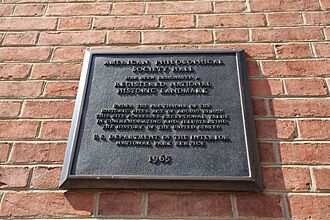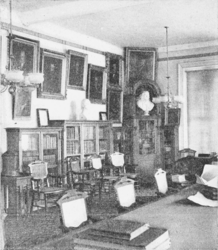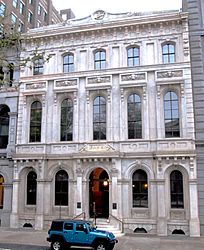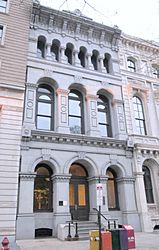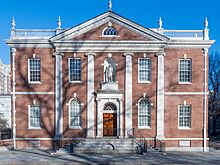American Philosophical Society facts for kids
|
American Philosophical Society Hall
|
|
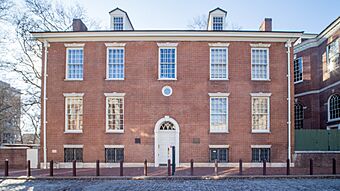
Philosophical Hall, the headquarters of the American Philosophical Society in Philadelphia
|
|
| Location | 104 S. Fifth St., Philadelphia, Pennsylvania, U.S. |
|---|---|
| Built | 1787 |
| Architect | Samuel Vaughan |
| Architectural style | Georgian |
| NRHP reference No. | 66000675 |
Quick facts for kids Significant dates |
|
| Added to NRHP | January 12, 1965 |
| Designated NHL | January 12, 1965 |
The American Philosophical Society (APS) is an important group in the United States. It was started in 1743 in Philadelphia. This group helps people learn more about many subjects. These include the humanities (like history and literature) and the natural sciences (like biology and physics).
The APS does this by supporting research and holding meetings. They also publish books and journals. They have a large library and help the community. Benjamin Franklin, a famous inventor and statesman, founded the society. It was the very first group of its kind in what became the United States.
Philosophical Hall is the main building for the society. It also has a museum. This building is near Independence Hall in Independence National Historical Park. In 1965, Philosophical Hall was named a National Historic Landmark. This was because of its important history.
The society has about 1,000 members today. Since it began, over 5,700 people have joined. The APS helps many different fields of study. They offer money for research and publish journals. They also have a museum and a huge library.
Contents
The History of the APS
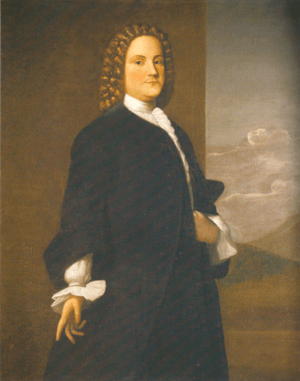
The American Philosophical Society started in 1743. It was first called the Philosophical Society. Benjamin Franklin and his friends created it. It grew out of an earlier club called the Junto.
Many important people were early members. These included George Washington, John Adams, and Thomas Jefferson. Other famous members were Benjamin Rush and James Madison.
It was common for such groups to invite people from all over the world. The society welcomed members from other countries. These included Alexander von Humboldt and the Marquis de Lafayette. The society was not very active for a few years. But it started up again in 1767.
On January 2, 1769, the society joined with another group. They became the American Philosophical Society Held at Philadelphia for Promoting Useful Knowledge. Benjamin Franklin was chosen as the first president.
During this time, the society had a special committee. This committee looked for ways to improve America. One idea they studied was a canal. This canal would connect the Chesapeake Bay and the Delaware River. The Chesapeake and Delaware Canal was later built in the 1820s.
After the American Revolutionary War, the society needed new leaders. Francis Hopkinson, who signed the United States Declaration of Independence, helped lead them. Because of him, the society received land from Pennsylvania. This included the land where Philosophical Hall now stands.
Many famous people have been members of the society. These include Charles Darwin, Robert Frost, and Louis Pasteur. Other notable members were Maria Mitchell and Thomas Edison.
Who Can Join the APS?
Being a member of the APS means you have achieved amazing things. This can be in any field of study. The society has about 1,000 members. About 840 are "resident" members. These are U.S. citizens or people living in the U.S. About 160 are "international" members from other countries. As of February 2025, over 5,890 people have been elected as members.
Many members have come from top universities. For example, 220 members have been from Harvard University. Princeton University has had 117 members. Stanford University has had 91 members.
Here are some of the universities with many members:
| Institution | Members (1743–2024) |
|---|---|
| Harvard | 220 |
| Princeton | 117 |
| Stanford | 91 |
| Berkeley | 86 |
| Columbia | 76 |
| Chicago | 73 |
| Penn | 67 |
| Yale | 63 |
| MIT | 58 |
| NYU | 42 |
Awards and Prizes
The society gives out several important awards. In 1786, they started the Magellanic Premium. This award is for achievements in navigation, astronomy, or natural philosophy. It is the oldest science prize given by an American group. They still give it out today.
Other awards include:
- The Barzun Prize for cultural history.
- The Judson Daland Prize for medical research.
- The Benjamin Franklin Medal for science achievements.
- The Lashley Award for brain science (neurobiology).
- The Lewis Award for the best book published by the society.
- The Thomas Jefferson Medal for achievements in arts, humanities, or social sciences.
Buildings of the APS
Philosophical Hall
Philosophical Hall is at 104 South Fifth Street in Philadelphia. It is between Chestnut and Walnut Streets. The building was constructed from 1785 to 1789. Samuel Vaughan designed it in the Federal style.
A third floor was added in 1890. This was to hold the growing library. But it was removed in 1948–1950. The building was then made to look like its original design. This was for the creation of Independence National Historical Park.
In 2001, Philosophical Hall opened as a museum. It has changing exhibits about history, art, and science. The museum shows art, science tools, and old writings. It also has rare books and natural history items from the APS collections.
Library Hall
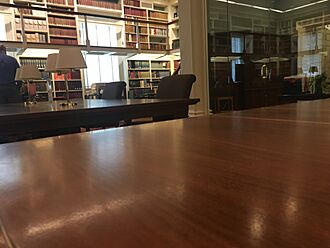
In 1789–90, the Library Company of Philadelphia built its main building. It was right across 5th Street from the APS. In 1884, the Library Company sold its building. It was torn down for a new bank building. That bank building was also torn down in the 1950s. This happened when Independence National Historical Park was being created.
The APS built a new library on this spot in 1958. They made its front look like the old Library Company building.
Benjamin Franklin Hall
The APS fixed up an old bank building. It was built in 1854–55. John M. Gries designed it in the Italianate style. This building is now called Benjamin Franklin Hall. It is used for lectures and major events.
Richardson Hall
Richardson Hall is next to Benjamin Franklin Hall. It used to be another bank building. It was built from 1871–1873. Addison Hutton designed it. This building now holds offices. It also houses the Consortium for History of Science, Technology and Medicine.
Images for kids
-
Library Hall in 2024
-
Franklin Hall at the American Philosophical Hall, named for Benjamin Franklin, the organization's founder
See also
 In Spanish: Sociedad Filosófica Estadounidense para niños
In Spanish: Sociedad Filosófica Estadounidense para niños





